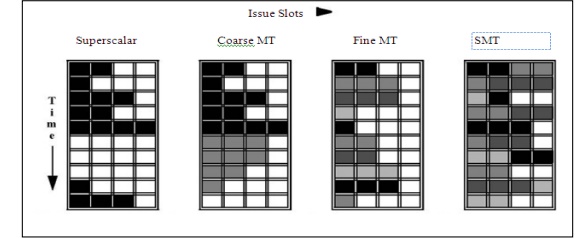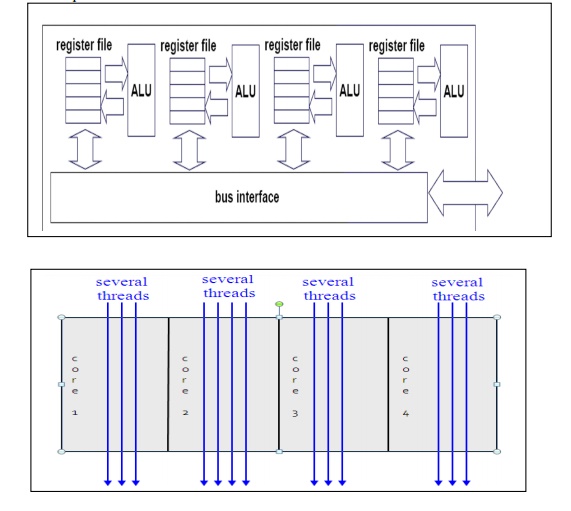Chapter: Computer Architecture : Parallelism
Hardware in Parallelism
HARDWARE
Exploiting Thread-Level
Parallelism within a Processor.
·
Multithreading allows multiple threads to share
the functional units of a single processor in an overlapping fashion.
·
To permit this sharing, the processor must
duplicate the independent state of each thread.
·
For example, a separate copy of the register file,
a separate PC, and a separate page table are required for each thread.
There are two main approaches to multithreading.
1. Fine-grained
multithreading switches between threads on each instruction, causing the
execution of multiples threads to be interleaved. This interleaving is often
done in a round-robin fashion, skipping any threads that are stalled at that
time.
2. Coarse-grained
multithreading was invented as an alternative to fine-grained multithreading.
Coarse-grained multithreading switches threads only on costly stalls, such as
level two cache misses. This change relieves the need to have thread-switching
be essentially free and is much less likely to slow the processor down, since
instructions from other threads will only be issued, when a thread encounters a
costly stall.
Simultaneous Multithreading:
·
Converting Thread-Level Parallelism into
Instruction-Level Parallelism.
·
Simultaneous multithreading (SMT) is a variation
on multithreading that uses the resources of a multiple issue,
dynamically-scheduled processor to exploit TLP at the same time it exploits
ILP.
·
The key insight that motivates SMT is that modern
multiple-issue processors often have more functional unit parallelism available
than a single thread can effectively use.
·
Furthermore, with register renaming and dynamic
scheduling, multiple instructions from independent threads can be issued
without regard to the dependences among them; the resolution of the dependences
can be handled by the dynamic scheduling capability.
The following figure
illustrates the differences in a processor’s ability to exploit the resources
of a superscalar for the following processor configurations:
·
a superscalar with no multithreading support,
·
a superscalar with coarse-grained multithreading,
·
a superscalar with fine-grained
multithreading, and
·
a superscalar with simultaneous multithreading.

·
In the superscalar without multithreading support,
the use of issue slots is limited by a lack of ILP.
·
In the coarse-grained multithreaded superscalar,
the long stalls are partially hidden by switching to another thread that uses
the resources of the processor.
·
In the fine-grained
case, the interleaving of threads eliminates fully empty slots. Because only
one thread issues instructions in a given clock cycle.In the SMT case,
thread-level parallelism (TLP) and instruction-level parallelism (ILP) are
exploited simultaneously; with multiple threads using the issue slots in a
single clock cycle.
·
The above figure greatly simplifies the real
operation of these processors it does illustrate the potential performance
advantages of multithreading in general and SMT in particular.
Motivation for Multi-core
¡ Exploits
increased feature-size and density
¡ Increases
functional units per chip (spatial efficiency)
¡ Limits
energy consumption per operation
¡ Constrains
growth in processor complexity
Ø A
multi-core processor is a processing system composed of two or more independent
cores (or CPUs). The cores are typically integrated onto a single integrated
circuit die (known as a chip multiprocessor or CMP), or they may be integrated
onto multiple dies in a single chip package.
Ø A
many-core processor is one in which the number of cores is large
enough that traditional multi-processor techniques are no longer
efficient - this threshold is somewhere in the range of several tens of cores -
and likely requires a network on chip.
Ø A
multi-core processor implements multiprocessing in a single physical package.
Cores in a multi-core device may be coupled together tightly or loosely. For
example, cores may or may not share caches, and they may implement message
passing or shared memory inter-core communication methods. Common network
topologies to interconnect cores include: bus, ring, 2-dimentional mesh, and
crossbar.
Ø All cores
are identical in symmetric multi-core systems and they are not identical in
asymmetric multi-core systems. Just as with single-processor systems, cores in
multi-core systems may implement architectures such as superscalar, vector
processing, or multithreading.
Ø Multi-core
processors are widely used across many application domains including:
general-purpose, embedded, network, digital signal processing, and graphics.
Ø The
amount of performance gained by the use of a multi-core processor is strongly
dependent on the software algorithms and implementation.
Ø Multi-core
processing is a growing industry trend as single core processors rapidly reach
the physical limits of possible complexity and speed.
Ø Companies
that have produced or are working on multi-core products include AMD, ARM,
Broadcom, Intel, and VIA.
Ø with a
shared on-chip cache memory, communication events can be reduced to just a
handful of processor cycles.
Ø therefore
with low latencies, communication delays have a much smaller impact on overall
performance.
Ø threads
can also be much smaller and still be effective
Ø automatic parallelization more
feasible.

Multiple cores run in parallel
Properties of Multi-core systems
¡ Cores
will be shared with a wide range of other applications dynamically.
¡ Load can
no longer be considered symmetric across the cores.
¡ Cores
will likely not be asymmetric as accelerators become common for scientific
hardware.
¡ Source
code will often be unavailable, preventing compilation against the specific
hardware configuration.
Applications that benefit from multi-core
¡ Database
servers
¡ Web
servers
¡ Telecommunication
markets
¡ Multimedia
applications
¡ Scientific
applications
¡
In general, applications with Thread-level
parallelism (as opposed to instruction-level parallelism
Related Topics